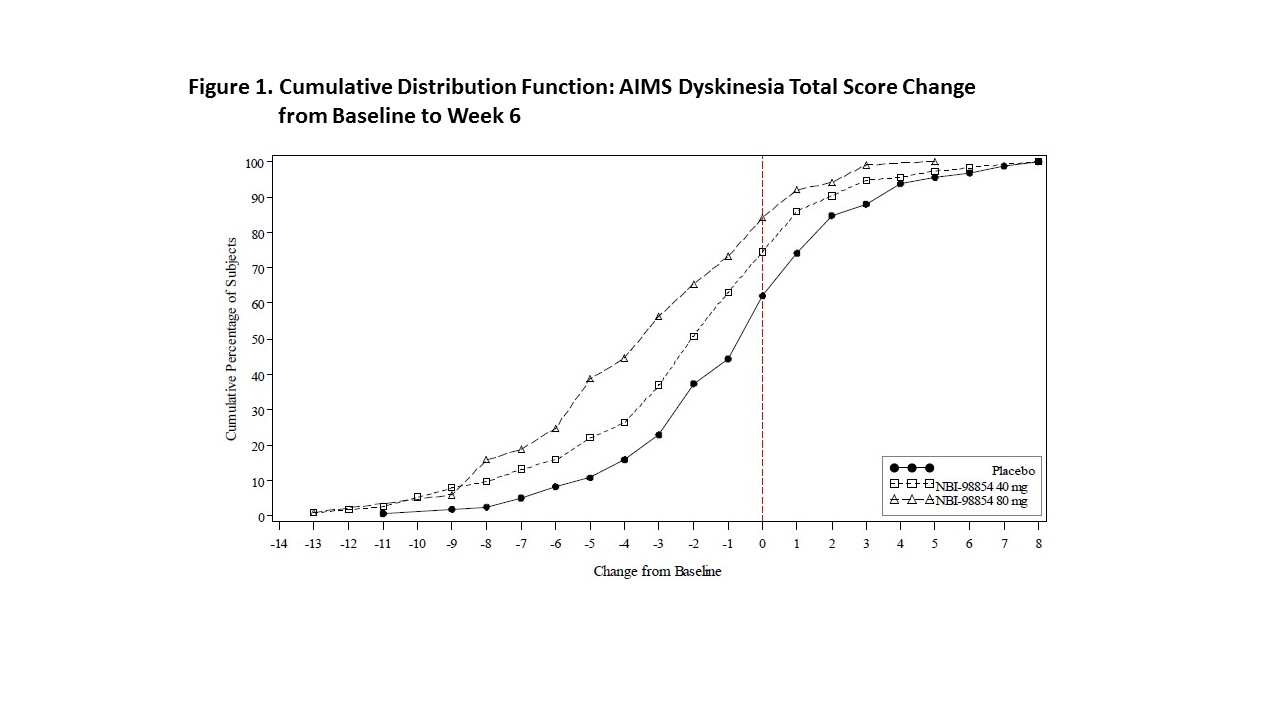Session Information
Date: Tuesday, June 6, 2017
Session Title: Drug-Induced Movement Disorders
Session Time: 1:45pm-3:15pm
Location: Exhibit Hall C
Objective: To establish a minimal clinically important difference (MCID) for Abnormal Involuntary Movement Scale (AIMS) dyskinesia total score change using data from randomized, double-blind, placebo (PBO)-controlled (DBPC) trials of valbenazine (VBZ, NBI-98854) in adults with tardive dyskinesia (TD).
Background: In DBPC trials, the effects of once-daily VBZ on TD were assessed using the AIMS dyskinesia total score (sum of items 1-7). Trial results showed AIMS score improvements to be significantly greater with VBZ than with PBO. The Clinical Global Impression of TD Improvement (CGI-TD) was used for anchor comparison.
Methods: Data were collected from three 6-week trials: KINECT (NCT01688037), KINECT 2 (NCT01733121), KINECT 3 (NCT02274558). To establish an MCID, AIMS mean score changes from baseline to Week 6 were analyzed in all subjects (VBZ and PBO groups pooled) with a CGI-TD score of ≤3 (minimally improved or better) or ≤2 (much improved or better). A cumulative distribution function (CDF) analysis was performed to assess the variability of AIMS score changes in each treatment group (pooled VBZ 80mg, VBZ 40mg [includes 50mg], PBO).
Results: In the pooled population (N=373), 72% and 29% of all subjects had CGI-TD scores of ≤3 and ≤2, respectively. In subjects with CGI-TD score ≤3, the AIMS mean score change to Week 6 was -2.2; in subjects with a score ≤2, the mean score change was -3.4. Most PBO-treated subjects had an AIMS score change of -4 to +4, which may represent the natural variability of TD severity [Figure 1], since the mean score change from baseline was -0.4. CDF curves also showed that the magnitude of improvement in PBO-treated subjects was less than the magnitude of improvement seen in VBZ-treated subjects. Moreover, with an increase in VBZ dose, CDF curves shifted to the left indicating dose-related improvement.
Conclusions: In 3 DBPC trials, a clear improvement in TD severity based on blinded, central video rating was corroborated by clinician global assessment using CGI-TD. Pooled data from these studies suggest that a 2‑point decrease in AIMS total score may represent the minimal clinically meaningful improvement. Larger AIMS score improvements were associated with “much improved” or “very much improved” CGI‑TD assessments, but the natural variability in TD severity may need to be considered when interpreting AIMS score changes in any individual subject.
To cite this abstract in AMA style:
M. Stacy, R. Kurlan, J. Burke, S. Siegert, G. Liang, C. O'Brien. An MCID for AIMS Dyskinesia Total Score Change in Subjects with Tardive Dyskinesia [abstract]. Mov Disord. 2017; 32 (suppl 2). https://www.mdsabstracts.org/abstract/an-mcid-for-aims-dyskinesia-total-score-change-in-subjects-with-tardive-dyskinesia/. Accessed December 8, 2025.« Back to 2017 International Congress
MDS Abstracts - https://www.mdsabstracts.org/abstract/an-mcid-for-aims-dyskinesia-total-score-change-in-subjects-with-tardive-dyskinesia/

